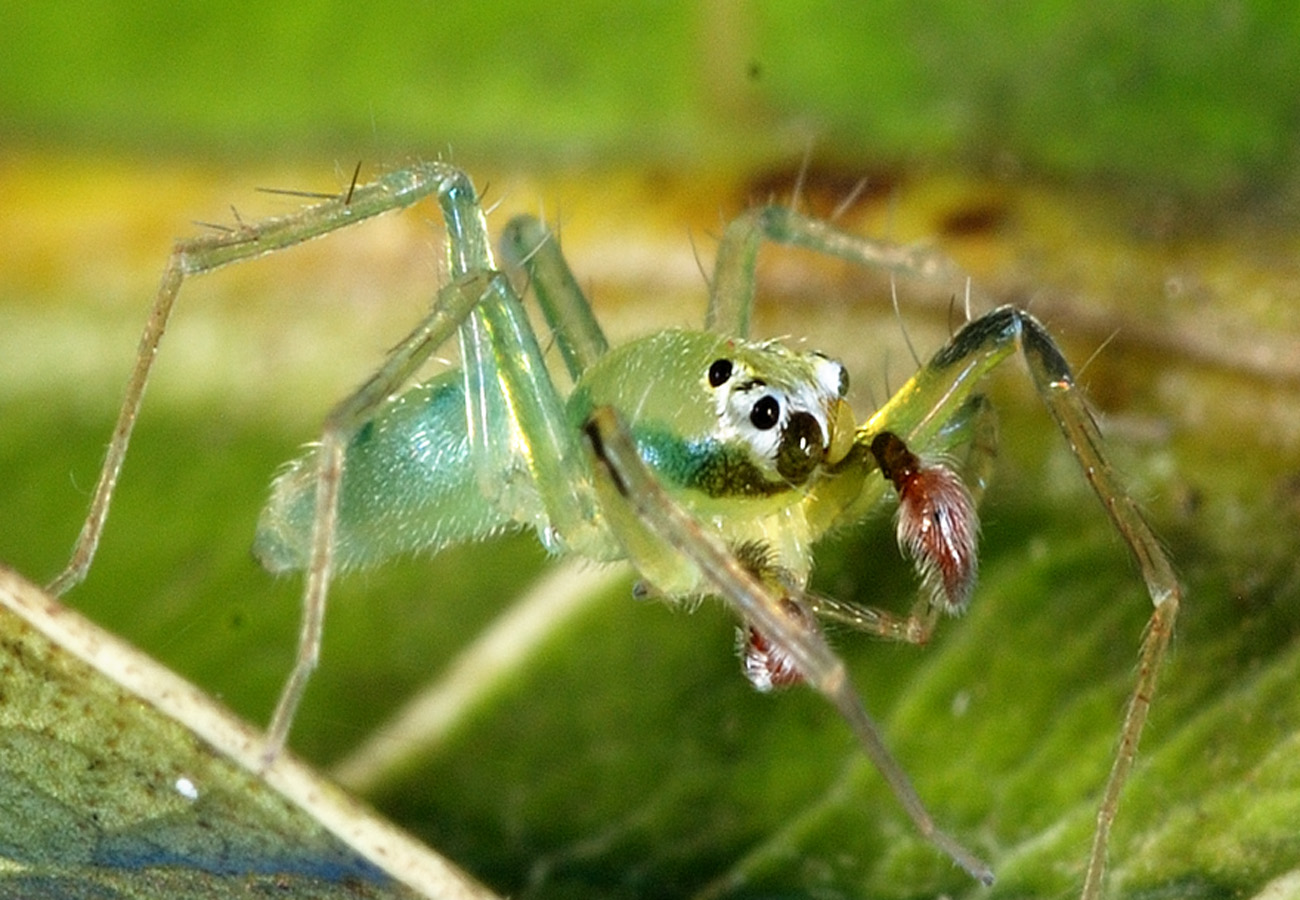Abstract
Spiders of the tropical Asian jumping spider genus Onomastus Simon, 1900 are small to medium-sized, delicate, translucent, commonly found inhabitants of Asian evergreen forest foliage. In this paper, three new species of the genus, O. jamestaylori sp. nov. (♂♀), O. corbetensis sp. nov. (♂♀) and O. maskeliya sp. nov. (♂♀) are described from Sri Lanka. The three new species are added to the matrix of a previous study to assess their phylogenetic position. The resulting cladistic analysis, based on 35 morphological characters from 18 taxa (13 Onomastus species and 5 outgroups) supports the monophyly of the genus. Additionally, a monophyletic, well-supported South Asian clade (India, Sri Lanka), which is restricted to the Sri Lanka-Western Ghats biodiversity hotspot, is recovered in most analysis. The three newly described species might be endangered due to their small population size and restricted distribution in high altitude cloud forest.
References
Benjamin, S.P. (2004) Taxonomic revision and a phylogenetic hypothesis for the jumping spider subfamily Ballinae (Araneae, Salticidae). Zoological Journal of the Linnean Society, 142, 1–82.
https://doi.org/10.1111/j.1096-3642.2004.00123.xBenjamin, S.P. (2006) The male of Marengo nitida with the description of M. rattotensis new species from Sri Lanka (Araneae: Salticidae). Zootaxa, 1326, 25–36.
Benjamin, S.P. (2010) Revision and cladistic analysis of the jumping spider genus Onomastus (Araneae: Salticidae). Zoological Journal of the Linnean Society, 159, 711–745.
https://doi.org/10.1111/j.1096-3642.2009.00580.xBenjamin, S.P. (2011) Phylogenetics and comparative morphology of crab spiders (Araneae: Dionycha, Thomisidae). Zootaxa, 3080, 1–108.
Benjamin, S.P. & Hormiga, G. (2009) Phylogenetic placement of the enigmatic genus Labullinyphia van Helsdingen, 1985, with redescription of Labullinyphia tersa (Simon, 1894) from Sri Lanka (Araneae: Linyphiidae). Contributions to Natural History, 12, 161–181.
Bremer, K. (1988) The limits of amino acid sequence data in angiosperm phylogenetic reconstruction. Evolution, 42. 795–803.
https://doi.org/10.2307/2408870Bremer, K. (1994) Branch support and tree stability. Cladistics, 10, 295–304.
https://doi.org/10.1111/j.1096-0031.1994.tb00179.xDingerkus, G. & Uhler, L.D. (1977) Enzyme clearing of alcian blue stained whole small vertebrates for demonstration of cartilage. Stain Technology, 52, 229–232.
https://doi.org/10.3109/10520297709116780Edwards, G.B. (2015) Freyinae, a major new subfamily of Neotropical jumping spiders (Araneae: Salticidae). Zootaxa, 4036, 1–87.
https://doi.org/10.11646/zootaxa.4036.1.1Farris, J.S. (1970) Methods for computing Wagner trees. Systematic Zoology, 19, 83–92.
https://doi.org/10.2307/2412028Fitch, W.M. (1971) Toward defining the course of evolution: minimum change for a specific tree topology. Systematic Biology, 20, 406–416.
https://doi.org/10.1093/sysbio/20.4.406Galiano, M.E. (1962) Redescripciones de especies del gnero Lyssomanes Hentz, 1845, basadas en los ejenplares tpicos. Descripcin de una especie nueva (Araneae: Salticidae). Acta zoologica Lilloana, 18, 45–97.
Galiano, M.E. (1980) Revisin del gnero Lyssomanes Hentz, 1845 (Araneae: Salticidae). Opera Lilloana, 30, 1–104.
Goloboff, P.A., Farris, J.S., Källersj, M., Oxelman, B., Ramírez, M.J. & Szumik, C.A. (2003) Improvements to resampling measures of group support. Cladistics, 19, 324–332.
https://doi.org/10.1111/j.1096-0031.2003.tb00376.xGoloboff, P.A., Farris, J.S. & Nixon, K. (2008) TNT: a free program for phylogenetic analysis. Cladistics, 24, 774–786.
https://doi.org/10.1111/j.1096-0031.2008.00217.xMaddison, W.P. (2015) A phylogenetic classification of jumping spiders (Araneae: Salticidae). Journal of Arachnology, 43, 231–292.
https://doi.org/10.1636/arac-43-03-231-292Maddison, W.P. & Maddison, D.R. (2009) Mesquite: a modular system for evolutionary analysis. In: Version 2.72 http://mesquiteproject.org
Maddison, W.P. & Needham, K.M. (2006) Lapsiines and hisponines as phylogenetically basal salticid spiders (Araneae: Salticidae). Zootaxa, 1255, 37–55.
Nixon, K.C. (2002) WinClada. Published by the Author, Ithaca, New York.
Ono, H. (1995) Four East Asian spiders of the families Eresidae, Araneidae, Thomisidae and Salticidae (Arachnida, Araneae). Bulletin of the national science museum, Series A (Zoology), 21, 157–156.
Prószyski, J. & Deeleman-Reinhold, C.L. (2013) Description of some Salticidae (Aranei) from the Malay Archipelago. III. Salticidae of Borneo, with comments on adjacent territories. Arthropoda Selecta, 22, 113–144.
Simon, E. (1900) tudes arachnologiques. 30e Mémoire. XLVII. Descriptions d'espèces nouvelles de la famille des Attidae. Annales de la Sociét entomologique de France, 69, 27–61.
Wanless, F.R. (1980a) A revision of the spider genera Asemonea and Pandisus (Araneae: Salticidae). Bulletin of the British Museum (Natural History) Zoology, 39, 213–257.
Wanless, F.R. (1980b) A revision of the spider genus Onomastus (Araneae: Salticidae). Bulletin of the British Museum (Natural History) Zoology, 39, 179–188.
Wanless, F.R. (1981) A revision of the spider genus Hispo (Araneae: Salticidae). Bulletin of the British Museum (Natural History) Zoology 41, 179–198.
World Spider Catalog (2016) World Spider Catalog. Natural History Museum Bern. [version 16.5] Available from: http://wsc.nmbe.ch (accessed 25 April 2016)
Zhang, J.X. & Li, D. (2005) Four new and one newly recorded species of the jumping spiders (Araneae: Salticidae: Lyssomaninae & Spartaeinae) from (sub) tropical China. Raffles Bulletin of Zoology, 53, 221–229.

